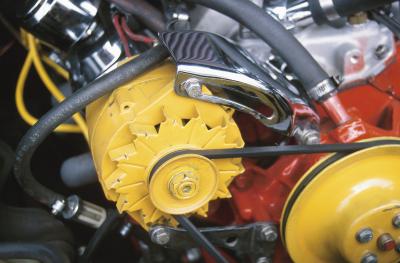
Protecting electrical equipment from fault conditions is a fundamental principle of good circuit design. A short circuit, one of the most dangerous faults, causes overheating and is a significant fire hazard. Short circuits generally draw heavy currents, and manufacturers use circuit breakers, fuses and fusible links to isolate equipment if an overload occurs. Fusible links, short lengths of wire usually sheathed in heat-resistant chlorosulfonated polyethylene, are four-wire gauges smaller than the circuit wiring they protect. Fusible links blow quickly when subjected to excess current.
Divide a page of heavyweight drawing paper into four columns. Head the columns from left to right: “Circuit-Wire Size (AWG #),” “Circuit-Wire Cross-Section (mm2),” “Fusible-Link-Wire Size (AWG #)” and “Fusible-Link Current Rating (A).”
Rule the page into rows, one row for each circuit-wire size to be included on your chart. On the first row of the left-hand column write the American Wire Gauge number of the smallest wire. For example, if the smallest wire on the chart is AWG 24, write “24.”
Write the AWG numbers of the other wire sizes in the left-hand column, one on each row in ascending order of size. A smaller AWG number signifies a larger wire size. Check a wire-gauge table for common sizes if you are unsure which to include (see References).
Check the first AWG number you wrote in the left-hand column. Find this wire size in a wire-gauge table and read across the table to find the cross-sectional area in square millimeters. Write this value in the second column of the same row, adjacent to the AWG number. For example, if the AWG number is 24, the cross-sectional area is 0.2 square millimeters and you should write “0.2.” Repeat for each row until you have recorded the cross-sectional area of each circuit wire on the chart.
Add four to the AWG number in the first row of the left-hand column. Write the answer in the third column of the same row, adjacent to the cross-sectional area. For example, if the AWG number is 24, write “28” in the third column. This is the wire size of the fusible link. Repeat for each row until you have recorded the wire size of the fusible link for each circuit wire on the chart.
Read the AWG number of the fusible link in the first row of the third column. Find this wire size in a wire-gauge table and read across the table to find the ampacity, or current-carrying capacity, in amperes. Write this value in the right-hand column of the same row, adjacent to the AWG number of the fusible link. For example, if the AWG number is 28, the ampacity is 0.36 amperes and you should write “0.36.” Repeat for each row until you have recorded the ampacity of each fusible-link wire on the chart.
Find the size of fusible link for a specified size of circuit wire. Find the circuit-wire size or cross-sectional area in the first or second column of the chart and read across the row to determine the required size and current-carrying capacity of the fusible link.